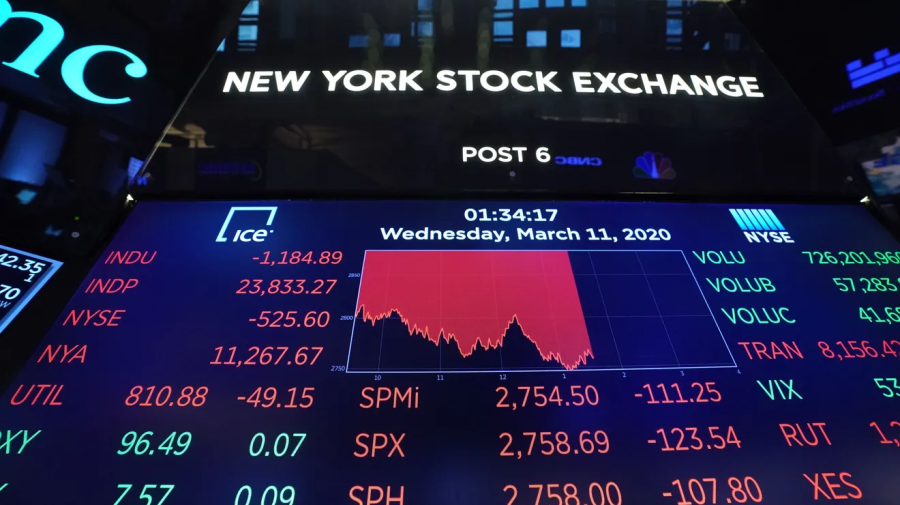
New York, NY – The U.S. stock market opened with significant losses on Monday, reflecting a wave of global market declines triggered by growing fears of an economic downturn in the United States. The S&P 500 Index dropped 4.2%, while the NASDAQ 100 fell by 5.4%, as major technology stocks took a substantial hit.
Tech Stocks Lead the Decline
Leading the downturn were some of the most prominent names in technology. Nvidia, Apple, Amazon, and Google experienced sharp declines, driving investors to seek refuge in U.S. treasuries. This flight to safety caused mortgage rates to fall, creating potential opportunities for borrowers to refinance.
Investor Anxiety and Economic Indicators
The panic that swept through the market has been building for several days. Over the weekend, billionaire investor Warren Buffett sparked concern by significantly increasing Berkshire Hathaway’s cash holdings to $276.9 billion as of June 30, up from $189 billion, largely by selling portions of its Apple stock. This move heightened fears of an economic slowdown.
Economic data released on Friday added to the anxiety. The Labor Department reported that the U.S. economy added only 114,000 jobs in July, with the unemployment rate rising to 4.3%, the highest level since October 2021. These figures were worse than economists’ forecasts, fueling recession fears.
The Sahm Rule and Recession Worries
Economists were particularly concerned about the sharp rise in the jobless rate, which triggered the Sahm rule. This rule, named after former Federal Reserve economist Claudia Sahm, posits that if the unemployment rate increases by at least half a percentage point over the previous 12 months, the economy is likely in a recession. Historically, this rule has accurately predicted U.S. recessions since the 1970s.
Broader Market Impacts
The weak jobs report, combined with disappointing earnings updates from major companies like Amazon and Intel, and a lackluster U.S. factory activity survey, pushed the S&P 500, Nasdaq, and Dow Jones Industrial Average lower on Friday. The Nasdaq officially entered “correction” territory, marking a decline of at least 10% from a recent high.
Volatility Index and Market Terms Explained
Investor anxiety reached new heights, as evidenced by the CBOE Volatility Index (VIX), which logged its largest-ever intraday jump. The VIX surged to a high of 65.73, up about 42 points from its close on Friday, indicating severe market turmoil.
To help navigate the financial turbulence, here are some key market terms:
- Correction: A market drop of at least 10% from a recent high, typically occurring about once a year.
- Pullback: A retreat of 5% to 9.99% from a peak, considered healthy and often seen as buying opportunities.
- Volatility: The extent of market fluctuations within a period.
- Bear Market: A decline of 20% or more in a stock or market index.
- Bull Market: A sustained rise in stock prices without a 20% drop.
Impact on Treasuries and Federal Reserve Policies
The market turmoil has led to increased demand for U.S. treasuries, pushing yields to their lowest levels in over a year. This shift has raised expectations for future Federal Reserve rate cuts. The CME FedWatch tool now shows an 87.5% probability of a rate cut in September, with some economists predicting a more aggressive half-point reduction.
Federal Reserve’s Stance on Recession
Despite the economic concerns, Chicago Federal Reserve Bank President Austan Goolsbee stated that the current data does not indicate a recession. He emphasized the need for the Fed to stay adaptable to changing economic conditions to avoid overly restrictive interest rate policies.
Oil Prices and Global Tensions
Compounding the market fears, oil prices have dropped to a six-month low amid worries about a potential U.S. recession and escalating tensions in the Middle East. Secretary of State Antony Blinken warned of a possible Iranian attack on Israel within 24 to 48 hours, further unsettling investors. As a result, WTI crude oil prices fell to $72.96 per barrel, while Brent crude dropped to $76.30 per barrel.
Disclaimer: The information presented in this article is based on the available data and current events around the time of publication, to the best of our staff research and knowledge. It is intended for educational and informational purposes only, and should not be construed as professional advice, financial advice, sports betting advice, or life advice. It is simply our best guess, something to add to your research. We at Las Vegas Top Picks do our best to get stories accurate, but sometimes mistakes and biases happen, and it is always good to double-check other sources and media outlets to confirm stories and the factual details. The opinions expressed in this article do not necessarily reflect the overall opinion of Las Vegas Top Picks.








